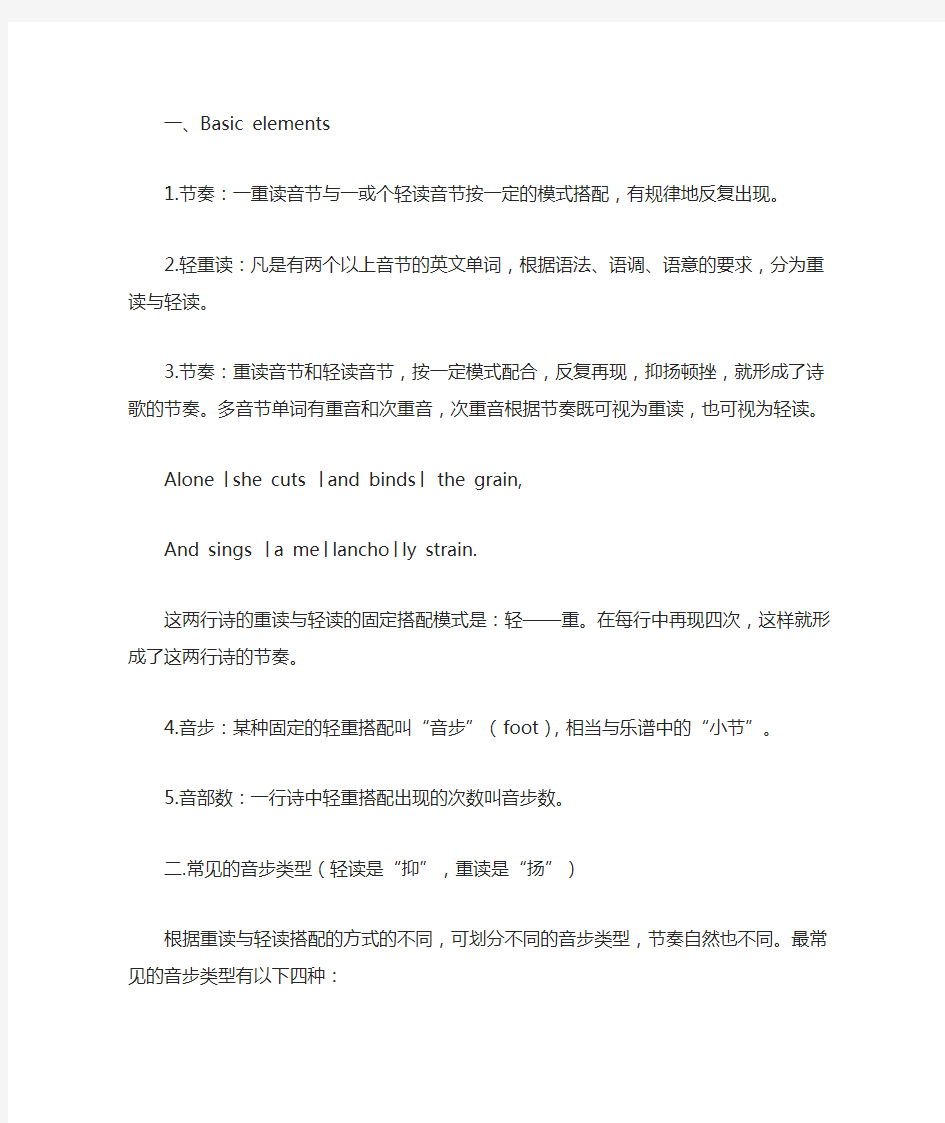
英国文学诗歌期末整理版
- 格式:docx
- 大小:24.98 KB
- 文档页数:7


一、Basic elements
1.节奏:一重读音节与一或个轻读音节按一定的模式搭配,有规律地反复出现。
2.轻重读:凡是有两个以上音节的英文单词,根据语法、语调、语意的要求,分为重读与轻读。
3.节奏:重读音节和轻读音节,按一定模式配合,反复再现,抑扬顿挫,就形成了诗歌的节奏。多音节单词有重音和次重音,次重音根据节奏既可视为重读,也可视为轻读。
Alone │she cuts │and binds│ the grain,
And sings │a me│lancho│ly strain.
这两行诗的重读与轻读的固定搭配模式是:轻——重。在每行中再现四次,这样就形成了这两行诗的节奏。
4.音步:某种固定的轻重搭配叫“音步”(foot),相当与乐谱中的“小节”。
5.音部数:一行诗中轻重搭配出现的次数叫音步数。
二.常见的音步类型(轻读是“抑”,重读是“扬”)
根据重读与轻读搭配的方式的不同,可划分不同的音步类型,节奏自然也不同。最常见的音步类型有以下四种:
1.抑扬格(iamb, iambic)
若一个音步中有两个音节,前者为轻,后者为重
2. 扬抑格(trochee, trochaic)
若一音步中有两个音节,前者为重,后者为轻。
Present │mirth has │present │laughter
Shake your │chains to │earth like │dew
3.抑抑扬格(Anapaest, anapaestic)
抑抑扬格含三个音节,即轻——轻——重。
The Assyr│ian came down │like the wolf │on the fold,
And his coh│orts were glea│ming in purp│le and gold;
And the sheen│of their spears│was like stars│on the sea,
When the blue │waves rolls night│ly on deep │Galilee.
4.扬抑抑格(dactyl, dactylic).
重——轻——轻
Dragging the │corn by her │golden hair.
抑抑格(pyrrhic[/peirik]和扬扬格(spondee[/sp :ndi])
以抑扬格为主要节奏写成的,就称此诗为抑扬格诗。现代兴起的一些自由诗(Free verse),不受这些格律的限制。
三、诗行(line)
1.一诗行不一定是一个完整的句子。
英文诗每行的第一个字母都大写,但是一诗行不一定是一个完整的句子,不一定能表达一个完整的意思。有时一行诗正好是一句
(end-stopped line结句行),有时两行甚至许多行才构成一个意思完整的句子(run-on line跨行句)。
I shot an arrow into the air,
It fell to earth, I knew not where;
For, so swiftly it flew, the sight
Could not follow it in its flight.
前两行是end-stopped line,后两行是run-on line。
2.诗行的长短以音步数目计算:(Meter步律)
英文诗行的长度范围一般是一音步至五音步。六、七、八音步的诗行很少,最常见的是四音步、五音步的诗。
一音步诗:monometer
二音步诗:dimeter(two feet)
三音步诗:trimeter(three feet)
四音步诗:tetrameter (four feet)
五音步诗:pentameter
六音步诗:hexameter
七音步诗:heptameter
八音步诗:octameter.
3.格律(meter)
一首诗的音步类型和诗行所含的音步数目构成此诗的格律。
You beat│your pate, │and fan│cy wit │will come:
Knock as│you please, │there’s no│body│at home.
此诗的基本音步类型是抑扬格,每行五音步。因此称此诗的格律是“抑扬格五音步”(iambic pentameter)。
4. Metrical patterns(格律的形式)
Iambic pentameter抑扬格五音步(John Milton, Paradise Lost)
Dactylic hexameter 扬抑抑格六音步(Homer, Iliad)
Iambic tetrameter 抑扬格四音步
Trochaic octameter扬抑格八音步
Anapestic tetrameter抑抑扬格四音步(Lewis Carroll, Don Juan) Alexandrine(also known as iambic hexameter抑扬格六音步)
四、压韵(Rhyming schemes 韵式)
押韵是指通过重复元音或辅音以达到一定音韵效果的诗歌写作手法。
1.全韵与半韵(full rhyme and half rhyme)。
2.尾韵与行内韵(end rhyme and internal rhyme)
尾韵:押在诗行最后一个重读音节上。
行内韵:诗行中间停顿处的重读音节与该行最后一个重读音节押韵。Spring, the sweet spring, is the year’s pleasant king;
Then blooms each thing, then maids dance in a ring,
3.阳韵与阴韵(masculine rhyme and feminine rhyme)
阳(单)韵:所押韵音局限于诗行中重读的末尾音节上。
如:late, fate; hill, fill; enjoy, destroy.
阴(双)韵:押韵押在两个音节上,后一音节非重读音节。
如:lighting, fighting; motion, ocean; wining, beginning.
看下面一节诗:
I am coming, little maiden,
With the pleasant sunshine laden;
With the honey for the bee,
With the blossom for the tree.